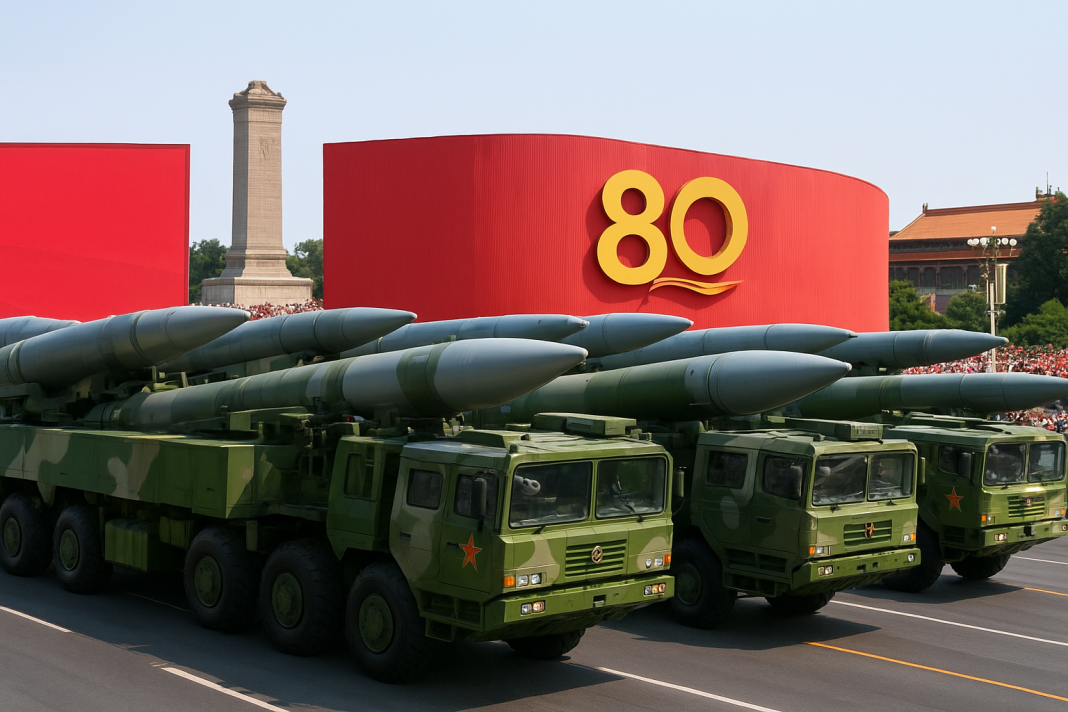China showcased a new line of interceptor missiles designed to strengthen its air and missile defense systems. The display took place during a large military parade at Tiananmen Square in Beijing, marking the 80th anniversary of World War II.
Massive Display of Interceptor Missiles in Beijing
China presented a total of six different interceptor missiles. The lineup included three air defense missile systems—the HQ-11, HQ-20, and HQ-22A—and three anti-ballistic missile systems—the HQ-9C, HQ-19, and HQ-29.
The Chinese military described these interceptor missiles as a “solid barrier” that defends the country from aircraft, drones, cruise missiles, and ballistic missiles. The military showed the systems as part of a wider strategy to build a multi-layered shield against incoming threats.
China military parade highlights Guam Killer missile and advanced anti-ship systems
The United States is working on its own large-scale missile defense system, known as the Golden Dome, valued at $175 billion. The U.S. expects this system to be operational by 2029 and aims to use it to protect the country against missiles of all kinds, including those traveling at hypersonic speeds.
Understanding the Interceptor Missiles and Defense Layers
China organizes its air and missile defense in layers, with each type of system protecting against different threats.
The HQ-11, HQ-20, and HQ-22A interceptor missiles counter low- and medium-altitude threats such as drones, aircraft, and cruise missiles. These systems create the first layer of defense and ensure that smaller, faster-moving targets do not reach sensitive areas.
For more serious threats like ballistic missiles, China deploys the HQ-9C, HQ-19, and HQ-29 interceptor missiles. These systems form the “upper layer” of defense. The HQ-9C intercepts ballistic missiles in the terminal phase—when they descend toward their target.
Putin says Russia and China reject trade sanctions that create unfair barriers
The HQ-19 serves a similar purpose but works at higher altitudes, increasing the chances of stopping missiles before they get too close. The HQ-29 focuses on the midcourse phase of flight, when a missile is moving through space after the initial launch. By covering different stages of flight, these interceptor missiles together create overlapping protection.
The U.S. Missile Defense Agency has explained that ballistic missiles fly in three main stages: boost, midcourse, and terminal. Each stage requires different interception techniques. China appears to have designed its interceptor missiles with this exact principle in mind, which makes it harder for hostile weapons to break through.
In addition to showcasing the interceptor missiles, China also displayed its newest nuclear missiles during the parade. Officials described them as having “global-covering” reach and “defense-penetrating” abilities, which highlights the country’s focus on both offense and defense in missile technology.
Comparison With U.S. Missile Defense
The United States has already built a range of missile defense systems. These include the Aegis system deployed on naval ships, the Ground-Based Midcourse Defense system, the Terminal High Altitude Area Defense (THAAD), and the Patriot system. Together, they provide multiple options to defend against different missile threats.
In addition to these weapons, the U.S. has developed a large sensor network made up of satellites and radars. These sensors help track missiles across their flight path, providing early warnings and guiding interceptors to their targets.
China’s new interceptor missiles, shown in Beijing, mirror this layered approach to defense. The Global Times described the systems as capable of “multiple-course, multi-layer” interception. This means they are designed to strike missiles in different phases of their journey.
The U.S. plans the Golden Dome project as a much larger umbrella defense system. Its cost is estimated at $175 billion. U.S. intelligence reports say cruise missiles, ballistic missiles, and hypersonic weapons pose the main challenges for such programs. Hypersonic weapons can fly more than five times the speed of sound. They can also maneuver during flight, which makes them very difficult to intercept.
Pentagon Activates World’s Most Advanced Radar from Raytheon to Fight Hypersonic Threats
During the parade, China showcased a missile formation seen as a demonstration of strategic defense and deterrence. Reports noted that China is building a defense network with the HQ-11, HQ-20, HQ-22A, HQ-9C, HQ-19, and HQ-29 interceptor missiles. This network aims to protect the country’s airspace and national security.
U.S. defense assessments state that China and Russia are developing systems to test U.S. missile defenses. Analysts still view traditional ballistic missiles as the main threat to homeland security. The display showed that China is investing in offensive missiles as well as a protective shield compared to the U.S. Golden Dome.

